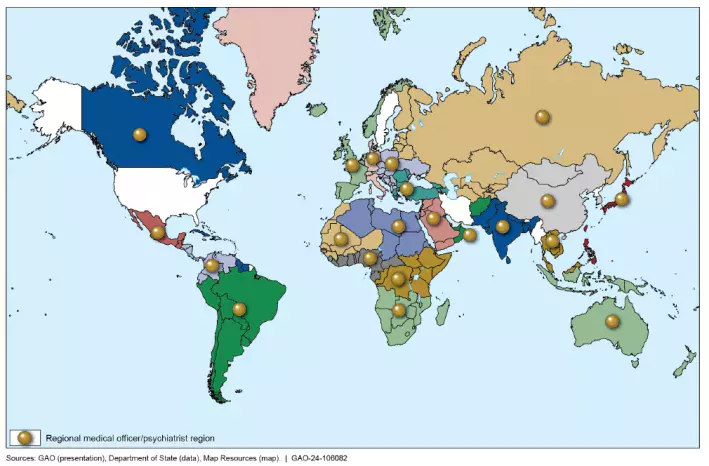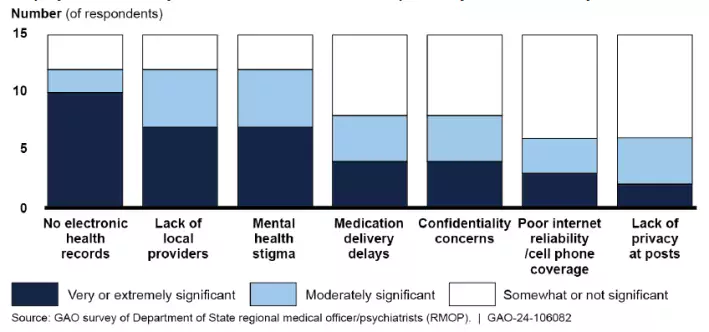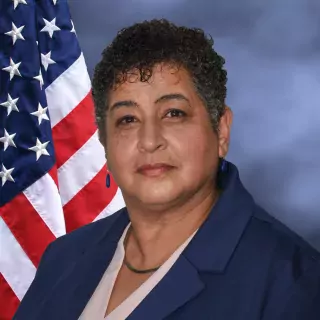For Those Who Serve the U.S. Abroad, Accessing Mental Health Care Can Be a Challenge
Many of us rely on our families, friends, communities, and mental health care professionals to help us navigate or alleviate the stress and challenges of everyday life. But for Americans serving their country overseas, they could face additional stressors—such as dangerous or unpredictable environments—while also (for many) being away from their families and having limited or no access to mental health care. Imagine facing these stressors and more while living overseas, sometimes in dangerous or unpredictable environments.
In a new report, we looked at some of the challenges State Department and U.S. Agency for International Development (USAID) employees face living abroad and accessing mental health care. Today’s WatchBlog post looks at this work, as well as our other work on providing mental health services to military service members abroad.
Image

Making sure State and USAID employees’ and their families’ mental health needs are met
About 15,000 State and about 1,600 USAID employees, as well as their families, live and work overseas. They are stationed all over the globe, including conflict zones like Ukraine, Israel, and Niger.
To support these employees and their families, the State Department and USAID offer mental health services. For example, State employs 21 psychiatrists to serve employees and families overseas. Also, both agencies offer counseling services by phone or video conference. However, we found that employees and their families may struggle to make timely appointments or receive care. For example, each of State’s 21 psychiatrists is responsible for providing services at about 12 to 15 posts. Most told us they were able to visit some posts only once or twice in 2022, if at all.
Regions Covered by State Department’s Overseas Psychiatrists
Image

We surveyed these psychiatrists about their workload and other challenges they faced when providing care overseas. Most of them responded that the demand for care had risen, increasing their workloads and making it harder to provide the treatment needed. One psychiatrist reported a greater need for mental health services in the wake of COVID-19, especially among kids, teens, and families. Other State and USAID officials told us demand for short-term counseling services had also risen, due to the war in Ukraine, the COVID-19 pandemic, and other stressors.
Significance of Challenges to Providing Mental Health Services as Reported by the Overseas Psychiatrists
Image

We also surveyed Foreign Service employees. They reported some of the same challenges as the psychiatrists to delivering and accessing services, including stigma associated with seeking and receiving mental health services. One employee said there is “a massive stigma in the State Department against seeking mental health services.” The employee went on to say, “Mental health care is health care, and we should be encouraged to seek support given the extremely stressful natures of our jobs.”
State and USAID officials told us they recognized the need to provide additional services to meet increased demand. State officials also told us they were seeking funding for additional psychiatrists and social workers. USAID officials said they planned to increase funding for USAID’s counseling services. To help ensure that employees and their families are receiving the mental health care they need while serving our country abroad, we recommended that the State Department should regularly collect feedback from them about the mental health services offered.
Mental health care for military service members abroad
In recent years, the Department of Defense (DOD) has reported increases in the rate of suicide deaths among military service members. Service members stationed at remote installations outside the contiguous United States were among those who died.
For our 2022 report, military officials told us that service members at remote installations may face unique risk factors for suicide, such as extreme weather conditions (cold that can keep them indoors), social isolation, and limited access to behavioral health care. We found that, in spite of the potentially higher risks, DOD had not fully assessed suicide risk at these installations. Doing so would allow DOD to better understand and address unique risk factors and challenges. In our 2022 report, we recommended that DOD develop a process for assessing risk factors for suicide. Learn more about our work on military suicide prevention efforts by reading our May 2022 blog post.
If you want to learn more about GAO’s work on mental health, check out our key issue page on this topic.
- GAO’s fact-based, nonpartisan information helps Congress and federal agencies improve government. The WatchBlog lets us contextualize GAO’s work a little more for the public. Check out more of our posts at GAO.gov/blog.
GAO Contacts
Related Products

GAO's mission is to provide Congress with fact-based, nonpartisan information that can help improve federal government performance and ensure accountability for the benefit of the American people. GAO launched its WatchBlog in January, 2014, as part of its continuing effort to reach its audiences—Congress and the American people—where they are currently looking for information.
The blog format allows GAO to provide a little more context about its work than it can offer on its other social media platforms. Posts will tie GAO work to current events and the news; show how GAO’s work is affecting agencies or legislation; highlight reports, testimonies, and issue areas where GAO does work; and provide information about GAO itself, among other things.
Please send any feedback on GAO's WatchBlog to blog@gao.gov.





